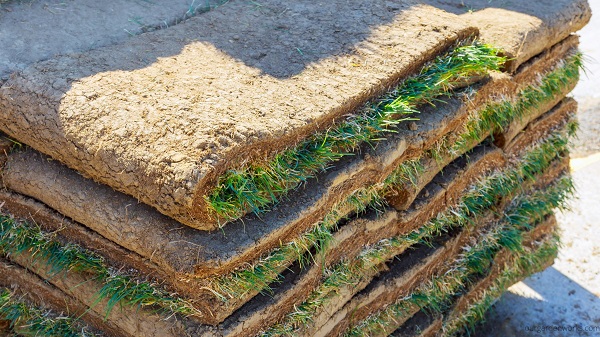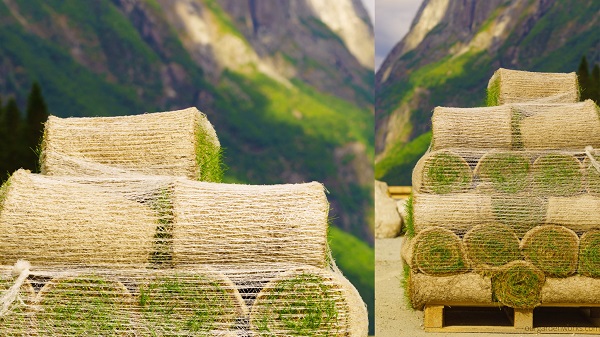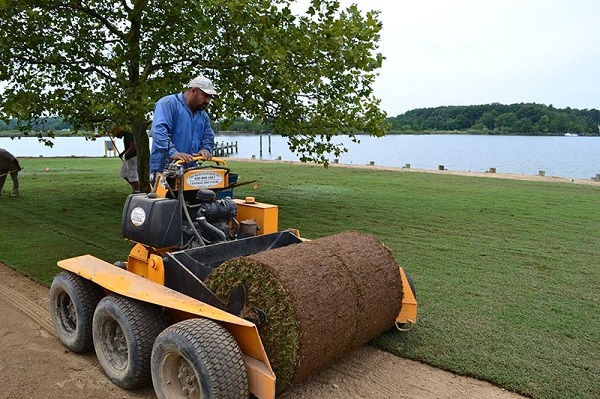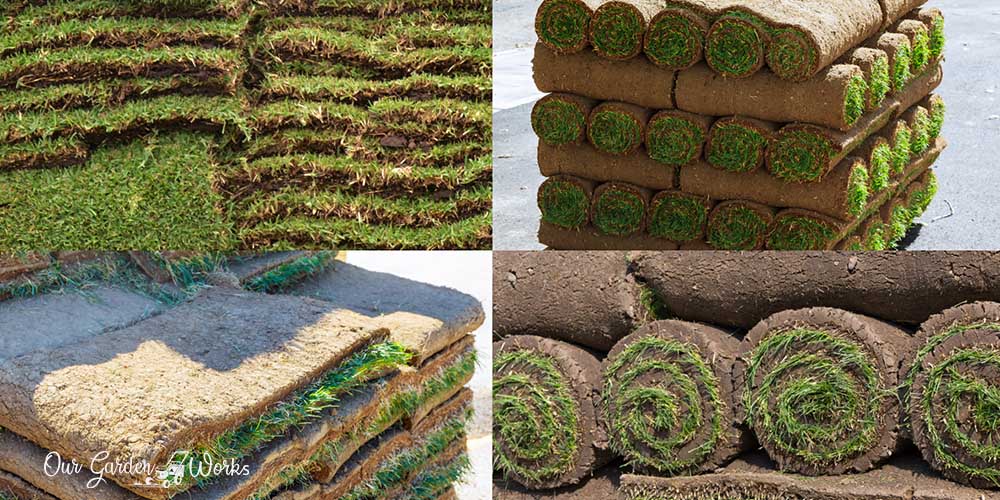Building a lawn through seeding requires a ton of work and time. The easiest solution that most gardeners do is lay sod, and the first question they ask would be, how many square feet is a pallet of sod?
Unlike other goods, sod is sold not by tile or piece but in pallets. So, most landscape service providers and homeowners use pallets to estimate or get a rough calculation of how much is needed for a lawn.
In this post, we will help you identify how many pallets of sod you will need to cover your lawn and the considerations you must ponder before investing.
However, before anything else, the key metric that you should identify is the square footage of sod per pallet due to the following reasons:
- It helps you determine how much pallet is needed.
- Sod is sold by the pallet, not by tile or patch.
- It is relative to the overall weight of the pallet which will dictate the type of vehicle you’ll need to transport it to your home.
Q: How Many Square Feet Is a Pallet of Sod?
A: A pallet of sod can have square footage that ranges from 400 to 750. Specific measurement depends on the sod supplier and how the sod is packed. The weight of each pallet can also increase by 30%-50% when wet or prepared on a rainy day.
The footage usually differs per supplier based on the type and shape of the sod. Northern and southern states in the US have different ways of handling sod.
With that, there can be a difference between what is available from your local sod provider from what you often see online.
Pro Tip: You should also prioritize the price per sq. ft. over the price per pallet to get a more accurate budgeting.
Considerations in Buying Sod
More than the scope of a pallet of sod, other factors can affect the price and the amount you’ll need for your project.
These include:
1. Size or Shape of Sod
Sod is prepared by suppliers in 3 different ways. It comes in slabs, small rolls, and big rolls.
Some suppliers roll the sod for safe transportation while others fold them into slabs. The square footage of each sod pallet also changes depending on the shape of the sod when packed.
Check more about these three sod shapes below:
Sod in Slab

If you’re living in the southern part of the US, then you’ve probably seen sod being sold in slabs. Every pallet of sod sold in slabs comes in varying square footage per pallet, such as
- 399 – 400 sq. ft.
- 450 – 452 sq. ft.
- 500 – 503 sq. ft.
Each slab comes in a rectangular shape and measures around 16 x 24 inches. Each slab can cover 2 to 3 sq. ft. each.
Using the projected coverage of each slab, a 400 sq. ft. pallet of sod slabs can contain 133 slabs while 500 sq. ft. pallets can contain around 167 sod slabs. In simple terms, the computation would be:
[ Total slabs in a pallet = Square footage of a pallet / Coverage of each slab (square foot) ]
The following grass varieties are sold in slabs:
- Bermudagrass
- Zoysiagrass
- St. Augustine grass
- Centipedegrass.
Reminder: Please note that the square footage of each sod slab pallet can vary depending on the supplier.
Sod in Mini Hand rolls

In the northern parts of the country, mini hand rolls of sod are becoming a trend. They no longer need equipment to be laid out on the lawn unlike big sod rolls and can be easily installed by hand.
They are usually used for cool-season grasses but can also be used for bermudagrass. Each pallet can have square footage of
- 400 sq. ft.
- 450 sq. ft.
- 500 sq. ft.
Each roll measures 40 x 18 inches and can cover approximately 5 sq. ft. each. Bermudagrass also comes in mini hand rolls which measure around 60 x 24 inches or 80 x 18 inches that can cover around 10 sq. ft of lawn.
Here’s a quick peek at how mini hand rolls of sod are prepared by suppliers: Click here!
To get how many mini hand rolls are there in a pallet, you can use this formula:
[ Total mini rolls per pallet = Square footage of a pallet / Coverage per roll (square foot) ]
For example, there would be 80 mini hand rolls in a 400 sq. ft pallet if each roll covers 5 sq. ft. each while a 10 square-foot bermudagrass mini hand roll comes in 40 rolls per pallet.
Mini hand rolls are laid down piece by piece so it requires a lot of time to install and a lot of lifting.
At the same time, the lawn will have a lot of seams which may not be ideal for functional yards like football and baseball fields.
Big Sod Rolls

Equipment-dependent big sod rolls are commonly used in northern states. Unlike mini hand rolls, they don’t come in pallets. Instead, they have a core that forklifts use to move them around.
Big rolls are often used on cold-season grass varieties like tall fescue and Kentucky bluegrass. The square footage of big sod rolls ranges from the following:
- 500 sq. ft.
- 600 sq. ft.
- 700 sq. ft.
Each big roll is loaded from the vehicle to the garden using a forklift. Once done, it will be attached to a sod roller that will rotate the roll and lay down the sod on the lawn.
Installing them is like laying down a big roll of carpet on your lawn which is much easier and requires less lifting. With that, it is the most ideal option for landscaping football and other sports fields.
However, big sod rolls also come with some disadvantages, such as:
- The sod in the middle of the roll will have no access to sunlight, water, and oxygen and may experience heat stress. This in turn will cause yellowing of the grass a day or two after installation.
- The tension in the ground left by the sod roller can compress the soil beneath the newly installed sod, which can affect the way they adapt to their new environment.
2. Square Footage of Your Yard
The square footage of your yard is measured by getting its overall length and width by foot.
You can either use a tape measure or a meter stick for measuring the square footage of your lawn. Once you get the length and width, you will multiply it to get the square footage of your lawn. The formula is as follows:
[ Total square footage of a lawn = yard length (ft.) x yard width (ft.) ]
The square footage of your property is a crucial metric to know how many pallets of sod you’ll need.
So, what about a circle or triangular yard?
Well, there will always be some parts of the yard that will not be entirely added to the total square footage like the nooks and crannies. So, it’s best to add about 5% to 10% of sod rolls or slabs to fill in the odd corners.
Not a fan of math? Here’s a sod calculator for a quick and time-saving solution to get the square footage and a rough estimation of the sod pallets you’ll need.
3. Weight of Sod
The weight of a sod pallet can range from 1,500 lbs. to 3,000 lbs. However, it can change based on the moisture content of sod and the soil attached to the roots.
Though the weight of the sod per pallet doesn’t affect the total square footage, it will dictate the vehicle you’ll need to get the pallets.
How To Buy and Install Sod on Your Lawn?
Growing grass is both labor-intensive and expensive. So, you should approach it with an educated decision by following these steps:
(1) Decide which type of sod you want for your lawn: Decide if you will only have warm-season grass or cold-season grass or both on your lawn. Then, start looking for turf or sod suppliers in your area.
(2) Get the square footage of your yard: As you find a supplier, the first thing they’ll ask you is the total square footage of your lawn. You may use the methods and formulas that we mentioned above.
(3) Ask your sod shop about sod size, pallet weight, and the square footage per pallet: To know how many pallets of sod to order, you should ask about the square footage and coverage of the sod slab or roll offered by your supplier per pallet.
The weight of the pallets also plays a role in knowing the vehicle that you’ll use to pick up your orders.
(4) Get the right vehicle to pick up the sod: Sod is quite heavy when it is wet when prepared or harvested. Also, you should prepare a forklift or sod roller if you’re buying big sod rolls.
(5) Install the sod on your lawn or hire a professional landscape artist: Sod rolls or slabs experience heat stress when they are left rolled or compressed for a long time. They need to be installed upon delivery to keep them alive. Otherwise, they will wilt and rot if you leave them uninstalled in your yard.
So, as soon as the pallets arrive in your yard, install them immediately so they can receive sunlight, moisture, and oxygen and stay green and alive.
Tips for Buying and Installing Sod
Dry and wilted sod are the common problems encountered by homeowners when laying new sod.
To make the most out of your new garden investment, here are some tips that you should adhere to before and during sod installation.
- No matter how accurately you measure the lawn, it’s always a best practice to add a few excess rolls or slabs of sod to fill in some oddly shaped corners and nooks of the lawn.
- Don’t leave sod rolls or slabs unrolled for days. They will develop molds and die from heat stress.
- Water the lawn three times a day for 10 days to help develop the roots and help them adapt to their new environment.
- Avoid stepping on the lawn for three weeks after installation to allow the grass to establish itself until it can handle light foot traffic.
- Prepare the soil before laying the sod to ensure successful grass growth. You can do this by removing rocks and debris, tilling them, and treating it with herbicide 15 days before installation.
Final Thoughts
Discovering how many square feet is a pallet of sod can make budgeting and cost estimation easier for you as a homeowner and for your landscape artist.
If you have a 1,000 sq. ft. yard and each pallet of sod has 450 sq. ft. coverage, you’ll need about two to three pallets of sod including some buffer for the corners in your yard.
We hope that this post helped you learn where to start in sod installation. The process may look intimidating but with the right tools, metrics, and help from professionals, you’ll achieve that green and lush lawn you’ve been dreaming of.
Let us know in the comments which sod shape works best for you. Is it a slab, mini hand roll, or big sod roll?
Also, please don’t forget to share this post with your friends to guide them in buying their sod and avoid making expensive mistakes.
